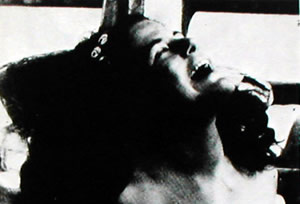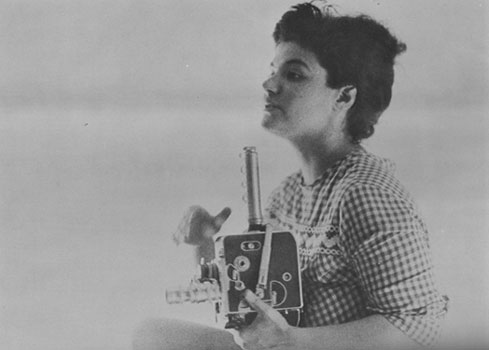Notes on Naomi Levine
by Gary Comenas (2011, revised 2014)
to 1961: ANDY WARHOL GOES TO UNDERGROUND SCREENINGS

Naomi Levine in
Tarzan and Jane Regained... Sort of
In POPism, Pat Hackett, writing as Andy Warhol, refers to Naomi Levine as "my first female superstar." Naomi Levine was also the first of Warhol's female superstars to appear naked in one of his films. (L&D183) In October 63, Andy and entourage went to Los Angeles for his second show at the Ferus Gallery (Liz/Elvis). While in LA they shot some footage for Tarzan and Jane Regained... Sort Of at the home of John Houseman, arranged through a friend of a friend of Wynn Chamberlain who was part of Andy's entourage. When they went to the pool, Naomi stripped off completely and jumped in. (POP44) Naomi had flown to LA separately in order (according to her) to raise funds for Jonas Mekas' Film-Makers' Co-Op. Gerard Malanga and Taylor Mead, who had driven there with Andy, claimed that Naomi was actually in love with Andy and she was disappointed that they hadn't asked her along. (POP43-4) According Warhol biographer Victor Bockris, Levine flew back to New York after Warhol screamed at her angrily for trying to pull his wig off during a visit to Disneyland. (L&D184)
Jonas Mekas credited Naomi Levine with bringing Warhol to his attention. Mekas' Film-Makers' Co-op screened and distributed many of Warhol's early films.
Jonas Mekas:
"I do not remember, strange as it may seem, but I could put it this way: In 1962, '63, '64, Film Makers' Cooperative was located at 414 Park Avenue South. It was much going, those years. It was a very busy period in New York in the Independent Film area, and the Co-Operative was the meeting ground for, ah, during that period, where the filmmakers stopped by during the day. During the evening, I was living there in the back of the Co-Op space. I gave the front of my space to the Co-Op - the front part was the Co-Op proper during the day. In the evening, it was a sort of night co-op, and during the evenings or afternoons, whenever a filmmaker felt that he wanted to show films to a friend or some[one], he could come in and screen. There was always projectors set up. And in the evenings, practically every evening, there was some little screenings... It was only that filmmakers knew and friends knew that, and this increased when we seemed to have at some films problems, censorship-wise, with public screenings. So, those films were usually screened by filmmakers and their friends at the Co-Operative.
And one day, Naomi Levine, who made films but s[he] started as a painter - I said, 'Why don't you come for my birthday,' or something. She came to my place. 'Andy Warhol is coming, too.' I said, 'Andy Warhol?' You know. 'I don't know Andy Warhol.' 'What do you mean you don't know Andy Warhol?! I met him at your place!' 'You met him at my place?' 'He's been there for months, watching those films.' I said 'I don't know him. I wouldn't know who those people are.'
So, he's been there watching those films at the Co-Op, at my place, but I did not know that that was Warhol, as I did not know many other people. So, then, I think, I met him probaby at her place, and then, I recognized him. Yes, I have seen him there. It was Warhol.
And sometime in '63, late '63. And, then, of course, he used to come to the Gramercy Arts [Theatre] on 62nd [Street], it is. And in '63, actually, he was already projecting, bringing, his films to Gramercy Arts Theatre... And he brought in his early Kiss - reels of of Kiss films." (PS415)
In addition to the informal screenings in his front room, Mekas used venues like the Gramercy Arts Theatre for official screenings. Prior to the Gramercy Arts he used the Charles Theatre. According to Tessa Hughes-Freeland in Naked Lens: Beat Cinema (London: Creation Books, 1997), Mekas used the Charles Theatre on Avenue B until 1963 for screenings and "then organized midnight screenings on Saturdays at the Bleeker Street Street Cinema before moving to the Gramercy Arts Theatre. (NL114)
In March 1964, the Gramercy Arts Theatre was closed by the License Department and the Film-Makers' Cooperative moved to the New Bowery Theatre. In his yearly round-up of notable underground cinema events during 1964 (published in the 7 January 1965 issue of The Village Voice) Mekas wrote that in April 1964, "A dark period in the New York film underground begins. No screenings for seven months. With no place to meet, film-makers' spirits go low. Clandestine screenings continue at the Co-op late into the summer, until the Co-op is raided and cops are placed nightly across the street." In November 1964 the Film-Makers' Cinematheque started using the New Yorker Theatre for screenings. The opening bill included Naomi Levine's film, Yes. (JM174-75)
By 5 May 1965 Mekas was holding screenings at the City Hall Cinema on 170 Nassau Street. A Film-makers' Cinematheque ad in the 27 May 1965 issue of The Village Voice announced that the "Film Makers' Cinematheque is moving from City Hall Cinema to an interim location which is the ASTOR PLACE PLAYHOUSE, 434 Lafayette Street New York... Our first program at the ASTOR PLACE will be in honor of Kenneth Anger's visit to New York." The Anger films were shown on 28, 29 and 30 May. (Village Voice, 7 May 1965, p. 19). On 1 December 1965 the Cinematheque moved to the 41st St. Theater at "125 West 41st St. or 120 West 42nd St. - in between 6th Avenue and Broadway." (Village Voice, 25 Nov 1965, p. 20).
Mekas also wrote a regular column for The Village Voice called "Movie Journal" and was an early supporter of Levine as an underground filmmaker:
Jonas Mekas (25 July 1963):
"Naomi Levine has just finished her first movie. It is like no other movie you ever saw. The rich sensuousness of her poetry floods the screen. Nobody has ever photographed flowers and children as Naomi did. No man would be able to get her poetry, her movements, her dreams. These are Naomi's dreams, and they reveal to us beauty which we men were not able to rip out of ourselves - Naomi's own beauty." (JM89)
In his 5 December 1963 column he mentioned Warhol's Kiss films which featured Naomi:
"Strange things have been going on lately at the Film-Makers' Showcase. Anti-film-makers are taking over. Andy Warhol serials brought the Pop Movie into existence. Is Andy Warhol really making movies, or is he playing a joke on us? - this is the talk of the town. To show a man sleeping, is this a movie? A three-minute kiss by Naomi Levine, is this art of kissing or art of cinema? If it is not cinema then what is it?" (JM109)
In addition to the Kiss film and Tarzan and Jane, Naomi's other films for Warhol included Batman Dracula and Couch.
Mekas interviewed Naomi Levine for his 24 December 1964 column. A copy of the interview can be found here.
Mekas also edited and published the underground film journal, Film Culture. He included Naomi in the photo feature, "Stars of the 'New American Cinema'," in the Summer 1964 issue. It also included photographs of Andy Warhol on two pages. Naomi was featured on four pages.

Naomi Levine in Film Culture, Summer 1964
It's not known why Naomi left the Factory or left New York. According to Victor Bockris it had something to do with Edie Sedgwick's arrival. Bockris claims in The Life and Death of Andy Warhol that "Edie's sudden rise to star status at the Factory delighted the gay boys... but her arrival was noted with chagrin by the other women... the temperamental, demanding Naomi freaked out, screaming at Andy that everything was his fault, and had to be hauled out onto the stairwell by Billy Linich [Name], slapped in the face and told to get the fuck out." (L&D222)
FILMS BY NAOMI
LEVINE (16mm)
(available from the Filmmakers
Cooperative)
YES (1963) 22.45
min
JEREMELU (1964) 2 min
OPTURED FRAIKEN CHAITRE JOE (1968) 3.15 min
PRISMATIC (1968) 19 1/2 min
FROM ZERO TO 16 (1969) 7 min
LONDON BRIDGES FALLING DOWN (1969) 4.5 min
PREMOONPTSS (1969) 10/15 min
AT MY MOTHER'S HOUSE (1970) 6 min
ZEN, AND THE ART OF BASEBALL (1970) 5.5 min
ASPECTS OF A HILL, PART 1: THE PERIPHERY (1971) 11.15 min
STORY OF A DOT (London, 1971) 2 min
ASPECTS OF A HILL PART II: THE GRASS (1972) 16.5 min